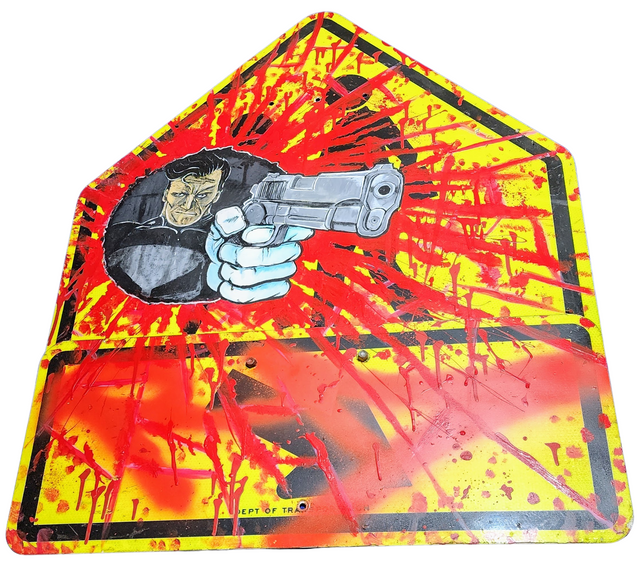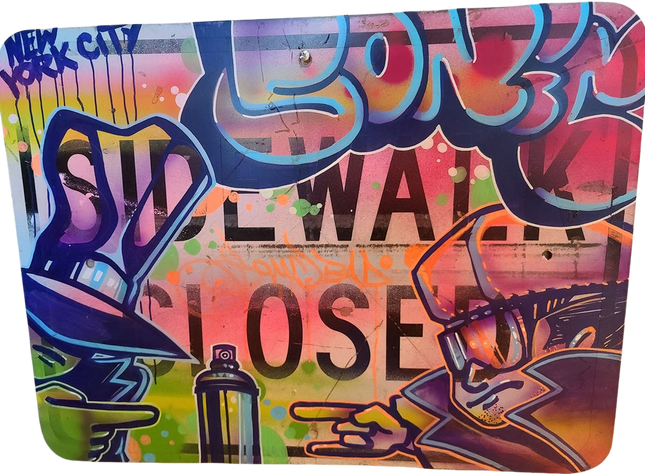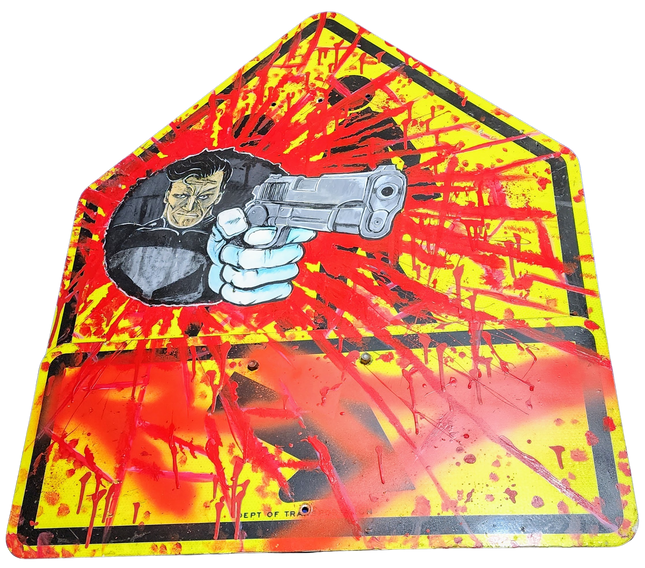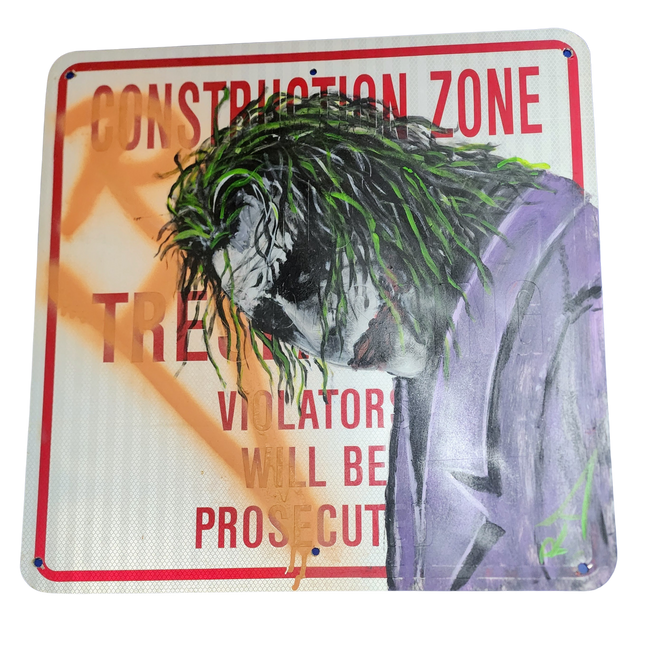
Street Signs

Sonic Bad Sidewalk Closed Original Mixed Media Street Sign Painting by Sonic Bad
Sidewalk Closed Original Mixed Media Graffiti Artist Modern Pop Art on Real Metal Street Sign by Sonic Bad. 2012 Signed Original Spray Paint & Metal Street Sign Artwork Size 24x18 Depicting 2 1970s-80s Stylized Beat Boys, NYC Graffiti Tags & Bubble Letters on Street Closed Sign Sonic Bad's Ode to the Streets: The 'Sidewalk Closed' Series The 'Sidewalk Closed' artwork by Sonic Bad, an original piece created in 2012, infuses the rebellious spirit of 1970s and 80s street culture into a medium that is emblematic of urban restriction: a real metal street sign. This mixed media work, signed by the artist, is a striking example of how street pop art and graffiti can repurpose public regulatory objects into canvases that challenge and reinterpret their original intent. Reclaiming Urban Symbols in Street Art Sonic Bad's choice of canvas—a metal street sign—turns an everyday symbol of control into a representation of creative liberation. The artwork, sized at 24x18 inches, is vibrant with color and life, presenting a stark contrast to the sign's mundane purpose of demarcating boundaries. By painting over it, Sonic Bad claims the object for art, much like graffiti artists claim walls for their tags and murals. The piece itself is a dynamic collage of NYC graffiti tags and bubble letters, styles deeply rooted in the history of street art. It showcases two stylized beat boys, figures that resonate with the hip-hop culture that was burgeoning on the streets of New York City during the 70s and 80s. These characters are not only representations of a specific era but also symbols of the energy and rhythm of street life. The Visual Language of Graffiti and Its Evolution Sonic Bad's work serves as a visual lexicon of graffiti's evolution, encapsulating the transition from tagging—often a raw, text-based expression of identity—to more complex and stylized works. The 'Sidewalk Closed' series is particularly evocative of this shift, highlighting the movement from simple letterforms to elaborate and colorful representations that are as much about the artistry of the line as they are about the message. The aerosol paint, a medium synonymous with graffiti, brings authenticity to the piece, its drips and opacity echoing the textures of street art seen in the wild. The metal sign, once reflective and directive, becomes muted and textured under layers of paint, a metaphor for the way street art can change the nature and conversation around public spaces and objects. Sonic Bad and the Living History of Street Art Sonic Bad's 'Sidewalk Closed' is more than a singular work; it is part of the living history of street pop art and graffiti artwork. It reflects a time when street culture began to permeate every aspect of urban life, from the music that played out of boomboxes to the art that adorned the walls and sidewalks of the city. This piece is a celebration of that era, a nod to the roots of street art, and a statement on its enduring influence. The artist, by merging nostalgia with contemporary expression, invites onlookers to explore the depth and breadth of street art. Through this work, Sonic Bad not only pays homage to the pioneers of the genre but also places himself within the continuum of artists who have utilized the street as their gallery. His legacy lies in his ability to transform the ordinary into the extraordinary, ensuring that the spirit of the streets remains vibrant and visible.
$2,000.00

RD-357 Real Deal Punisher Crossing Original Street Sign Painting by RD-357 Real Deal
Punisher Crossing Original Street Sign Painting by RD-357 Real Deal One of a Kind Artwork on Real Metal Crosswalk Street Sign by Graffiti Art Pop Artist. 2012 Signed Mixed Media Acrylic & Spray Paint on Real Reclaimed NYC New York City Crossing Cross Walk Street Sign Painting Original Artwork Size 30x37.5 RD-357: Pioneering Street Pop Art on Urban Canvases RD-357, an artist known for his distinctive contribution to street pop art and graffiti artwork, has manifested his creativity through a unique, striking, and thought-provoking medium. His original piece titled "Punisher Crossing Original Street Sign Painting" encapsulates street art's raw essence while ingeniously infusing pop culture iconography elements. This work is a stellar example of RD-357's inventive use of everyday objects as canvases, transforming a mundane metal crosswalk street sign into a vibrant artwork that commands attention and sparks dialogue. The "Punisher Crossing" is a unique artwork that exudes the rebellious spirit and subversive edge often associated with street pop art. Created in 2012, this mixed media piece employs acrylic and spray paint on a real crossing sign measuring 30x37.5 inches. RD-357's choice to use an actual street sign as the foundation for his artwork not only repurposes the object but also embeds the art piece within the fabric of urban life it seeks to comment on. The sign, once a directive for pedestrians, now carries a powerful visual message, made all the more potent by its placement on an object of regulation and order. The Artistic Language of RD-357's Street Sign Paintings In "Punisher Crossing," RD-357 demonstrates a masterful control over color and composition. The background of the sign is ablaze with a vivid, almost violent splatter of yellow and red spray paint, reminiscent of the chaos and energy of city streets. Against this explosive backdrop, the figure of the Punisher is rendered with precision in acrylic, his stark, menacing presence immediately drawing the eye. The character's hand, outstretched and holding a gun, breaks the boundaries of the sign's frame, suggesting a defiance of constraints and a breaking free from imposed limits. RD-357's work is deeply embedded in the language of street pop art, a genre that combines the gritty, underground aesthetic of street art with the bright, graphic quality of pop art. His paintings, especially this piece, are a dialogue between the artist and the urban landscape, between the fictional characters of pop culture and the reality of the viewer's environment. By bringing the Punisher - a symbol of vigilante justice and anti-heroism - into the context of a crosswalk sign, RD-357 creates a juxtaposition that is at once startling and intriguing. The artwork becomes a statement on control and chaos, power and powerlessness, and the fine line between societal order and individual action. RD-357's Impact on Contemporary Street Art RD-357's contributions to the street art scene have been significant, and his influence can be seen in the way street pop art has evolved over the years. His artworks, particularly those on street signs, are more than mere paintings; they are interventions into the urban environment, which challenge the viewer to reconsider the role and potential of public space. The "Punisher Crossing" sign is emblematic of this approach, seamlessly integrating art into the city's daily liandlso elevating the discourse around street art. By signing his work, the artist claims ownership of a public domain piece, an act that is a form of artistic rebellion. The signature on "Punisher Crossing" is not merely a mark of authenticity; it is a declaration of presence, a proof of the artist's interaction with the world around him. Through works like this, RD-357 has etched his name into the annals of street pop art history, securing his place as a maverick who has expanded the possibilities of graffiti artwork. The "Punisher Crossing Original Street Sign Painting" by RD-357 stands as a testament to the power of street pop art to communicate, provoke, and inspire. By transforming a simple street sign into a complex and compelling work of art, RD-357 challenges perceptions, invites reflection, and continues influencing the ever-evolving narrative of street and graffiti art.
$3,000.00

RD-357 Real Deal Ledger Joker Construction Street Sign Painting by RD-357 Real Deal
Heath Ledger Joker Construction Zone Original Street Sign Painting by RD-357 Real Deal One of a Kind Artwork on Real Metal NYC New York Construction Zone No Trespassing Street Sign by Graffiti Art Pop Artist. 2012 Signed Mixed Media Acrylic & Spray Paint on Reclaimed NYC New York Construction Zone No Trespassing Sign Painting Original Artwork Size 24x24 Batman Villian Played by Heath Ledger in the Movie as Joker Looking at the Viewer. RD Tag in Rust Red. RD-357's Heath Ledger Joker: A Fusion of Street Pop Art and Iconography The Heath Ledger Joker Construction Zone original street sign painting by RD-357, also known as Real Deal, encapsulates the essence of street pop art through its provocative use of public signage repurposed for artistic expression. Created in 2012, this mixed media acrylic and spray paint artwork transforms a New York City construction zone 'No Trespassing' sign into a canvas, depicting the iconic Batman villain played by Heath Ledger in a way that both challenges and captivates the viewer. Contextualizing RD-357's Artistic Approach RD-357, an artist whose real name remains elusive in the true spirit of street art anonymity, is known for his gritty interpretations of pop culture figures on unconventional canvases. This particular artwork measures 24x24 inches and is a testament to street art's versatility, pushing beyond traditional boundaries. RD-357 draws upon the anarchic spirit of the Joker, using a symbol of law and order – a construction sign – to present an image of chaos and rebellion. The irony is palpable; the sign, which once stood as a warning against unauthorized entry, now invites viewers to engage with the art in a personal, almost aggressive manner. Symbolism and Impact in RD-357's Joker Artwork This piece is not just a portrait; it is a statement. By choosing Heath Ledger's Joker, RD-357 taps into the collective consciousness of a society fascinated by the anti-hero archetype. Ledger's portrayal of the Joker was posthumously celebrated, and his death in 2008 left a cultural imprint that RD-357 leverages in this artwork. The juxtaposition of the Joker’s figure against the backdrop of a New York construction sign speaks volumes about the chaotic undercurrents within the perceived order of urban life. The use of mixed media, with acrylic and spray paint, highlights street art's raw, visceral nature, while also paying homage to the vibrancy of pop art. The viewer is confronted with the Joker's gaze, which, coupled with the bright warning colors of the construction sign, creates an unsettling yet magnetic presence. This interaction compels the audience to contemplate the layers of meaning behind the piece – from transforming public property into a medium for personal expression to the dialogue between art and spectator that challenges societal norms and the very definition of public space. In conclusion, RD-357's Heath Ledger Joker on a New York City construction sign is an outstanding example of how street pop art can merge cultural iconography with subversive messaging. Through this piece, the artist immortalizes a beloved film character and raises questions about authority, ownership, and the role of art in public discourse. The artwork remains a one-of-a-kind testament to the power of graffiti art to redefine spaces and provoke thought long after the paint has dried.
$3,000.00




